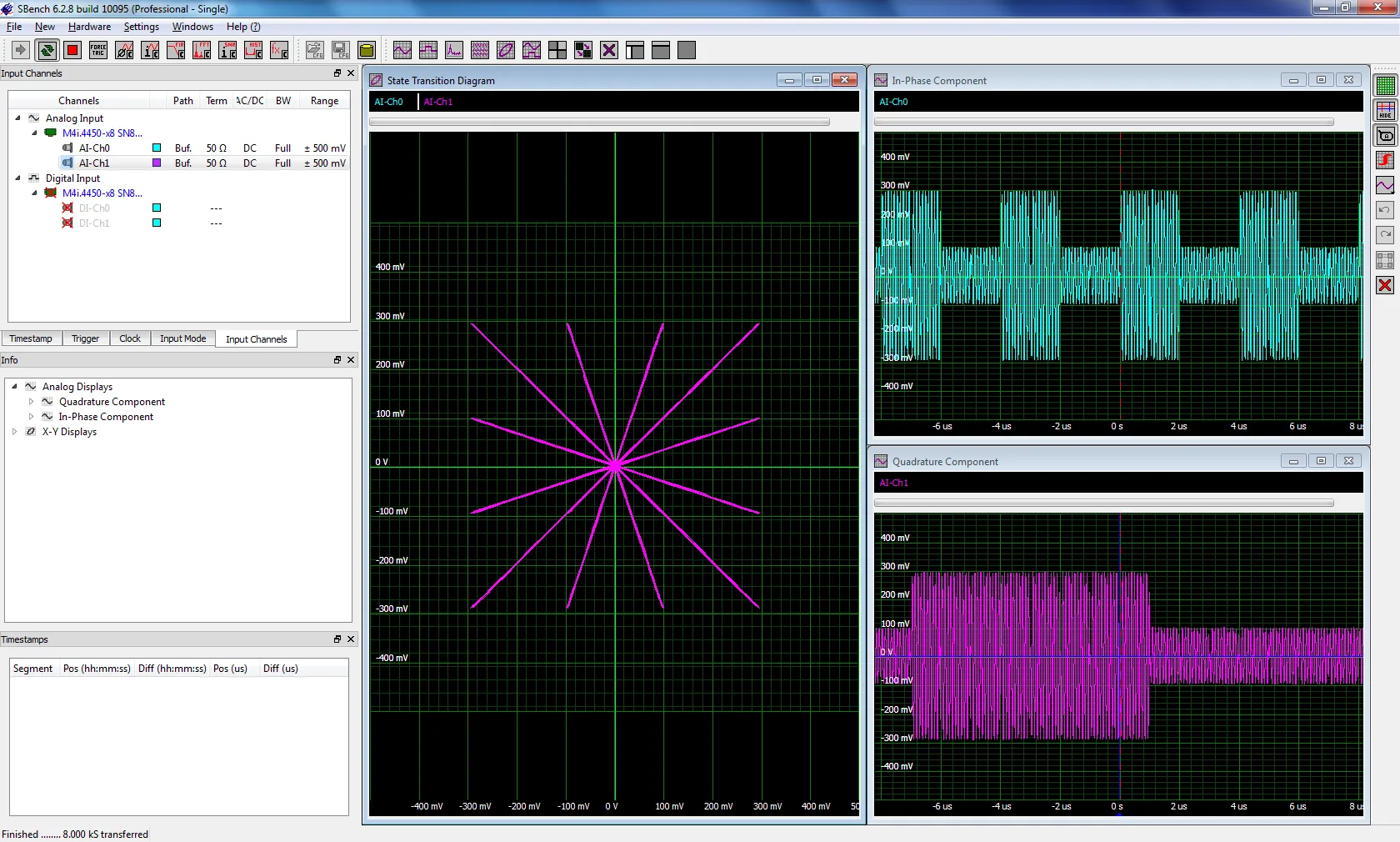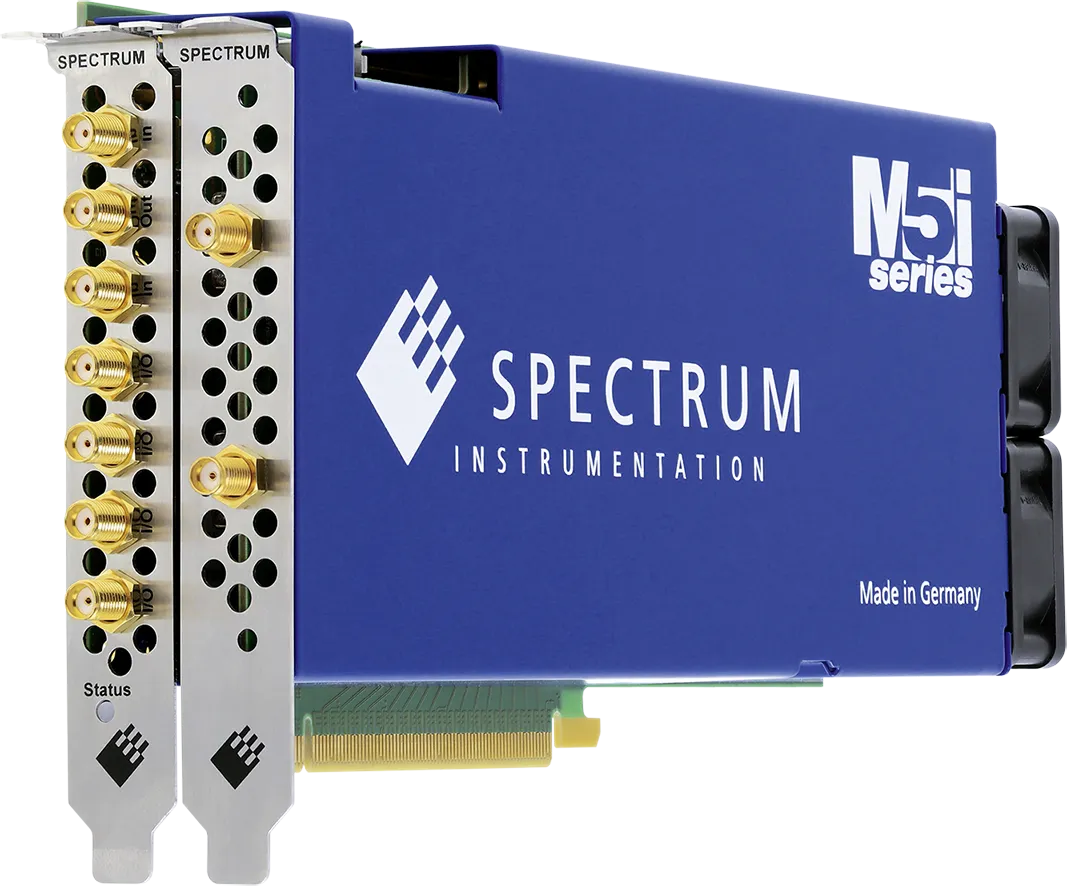Communications
Electronic communication continues to evolve as the world community continues to demand the transfer of more information at ever increasing speeds. Analog and digital technology is used in both point-to-point and broadcast communications that are being delivered by wireless, fiber optic and cable network systems. In order to develop and maintain these systems engineers need to be able to test and qualify the signals being received and transmitted. Signal loss or attenuation needs to be reduced, noise monitored and key parameters characterized. Furthermore, as systems become ever more complicated sources of error need to be detected quickly and corrected.
Utilizing the latest PC based technology, Spectrum digitizers and arbitrary waveform generators make excellent tools for the development, testing and operation of communication systems. They offer a wide range of bandwidths, sampling rates, and dynamic range allowing them to match the expanding range of communication measurement needs. When large dynamic range and maximum sensitivity is required high-resolution 14 and 16 bit digitizers are available for the capture and analysis of signals that go as high as 250 MHz in frequency. These high-resolution cards deliver outstanding signal-to-noise ratio's (up to 72 dB) and spurious free dynamic range (of up to 90 dB) so that small signal variations can be detected and analyzed.
For even higher frequencies 8 bit digitizers are available that offer up to 5 GS/s sampling rates and 1.5 GHz bandwidth. In wireless applications, where signal frequencies may even go above 1.5 GHz, the digitizer products can also be used with down-converters to further extended their operational frequency range. Each digitizer card can have from one to four channels (eight channels on lower speed cards) and up to eight cards can be linked together with Spectrum's Star-Hub system to create instruments with up to 32 fully synchronous channels making them suited to applications with multiple input and output (MIMO) transmitters and receivers. With large on-board memories (up to 4 GSamples/card) and advanced streaming and readout modes the digitizers are ideal for capturing long and complex communication signals. Using the streaming over the cards fast PCIe bus to a RAID based storage array allows the capture and storage of hours of information. Spectrum's SBench 6 software can also be used to view and qualify I and Q signals. FFT's are available for frequency domain analysis and parametric calculations can be used to characterize timing issues such as leading and trailing edge pulse jitter.
Typical communications applications include wireless systems using RF and microwave, MIMO, wireless LAN's, mobile phones, base station monitoring, surveillance, satellite communications, bus testing, cable testing, antenna and transmitter testing.
Spectrum Product Features
- 12, 14 and 16 Bit Resolution
- Sampling rates up to 10 GS/s and Bandwidth over 1.5 GHz
- Segmented Memory with FIFO Readout
- Streaming data to RAID disc array at up to 3 GByte/s continuously
- High SNR and SFDR
Matching Card Families
Related Documents

RF Measurements Using a Modular Digitizer
Modern modular digitizers, like the Spectrum M4i series PCIe digitizers, offer greater bandwidth and higher resolution at any given bandwidth than ever before. Although they are in the class of general purpose measuring instruments they are capable of many RF and lower microwave frequency measurements. This article focuses on some examples of common RF measurements that can be performed with these modular digitizers.

Stimulus-Response Systems with AWG and Digitizer
Self-excited electronics like power supplies, oscillators, transmitters, and signal generators can often be tested using a measuring instrument (digitizer, oscilloscope, spectrum analyzer, etc.) alone. Externally excited electronic devices like amplifiers, filters, receivers, and digital interfaces require a signal source and a measuring instrument for testing. Modular Arbitrary Waveform Generators (AWG's) and modular digitizers are available with multiple source and measurement channels that can be configured in bandwidth, sample rate, and memory.

Application examples for the ultrafast digitizers of the M5i.33xx series
The five models of the M5i.33xx-x16 digitizer series, with 10 GS/s maximum sampling rate, over 3 GHz bandwidth and 12 bit resolution, are well matched to a broad range of RF and high-speed digital applications. This application notes describes three different examples: measuring of RADAR pusles, Analyzing quadrature-modulated communication-signals and Analysing DDR 2 memory data signals
Research Papers
Multi-Heterodyne Interferometry
By using multi-heterodyne interferometry with a high resolution M4i.4471-x8 digitizer the State Key Laboratory of Precision Measurement Technology and Instruments, Tianjin University, Tianjin, China, has developed a method for making absolute distance measurements. Experimental results demonstrate an agreement within 750 nm over 80 m distances and an update rate of 167 μs. To see the full white paper click here:
Research PaperTest Signals for Multifunction Vehicle Bus
Find out how the College of Electrical Engineering, Zhejiang University, Hangzhou, China employ a Spectrum Digitizer M3i.4142 and a AWG M2i.6021 to provide test signals for multifunction vehicle bus (MVB) protocol testing (main article in Chinese) by clicking on the link below:
Research PaperDeep Neural Networks
At the Massachusetts Institute of Technology (MIT), Cambridge, USA, they are studying ways to enable computing on a new generation of edge devices with speeds comparable to modern digital electronics and power consumption that is orders of magnitude lower. A paper that discusses advances in deep neural networks (DNNs) is linked below. It outlines the experimental setup, which includes the use of two M2p.5943-x4 80 MS/s, 16-bit Digitizers to make a 16-channel acquisition system for collecting photodiode signals.
White PaperDirect-Comp Spectroscopy
The Department of Physics, Keio University, Japan is using an M4i.2230-x8 5 GS/s Digitizer for high speed data acquisition with fast time domain averaging to perform scan-free high-resolution direct-comb spectroscopy where the mode spacing of an optical frequency comb is reduced down to 260 kHz by phase modulation. Details on the development can be found here:
Research PaperCompact Indoor Localization System
Learn how a Spectrum digitizer M3i.2132 and UWB technology is used by Telecom ParisTech to develop a compact Indoor Localization System (article in French and English) by clicking here:
Arcticle (French and English)Visible Light Communication Systems
The School of Electrical & Electronic Engineering, Nanyang Technological University, Singapore, has been studying visible light communication systems that support wireless data access and indoor positioning applications. For precision multi-channel signal generation they use a Spectrum M4x. 6622-x4 AWG capable of outputting waveforms at rates up to 625 MS/s with 16 bit resolution. A dissertation paper on the research can be found here:
Dissertation PaperSecure Key Generation and Distribution
Cryptographic keys are a vital part of any security system as they control everything from data encryption and decryption to user authentication. The Fiber-Optic research Center, at Fudan University in China, has developed a secure key generation and distribution scheme based on the phase noise of an amplified spontaneous emission source. Experimental results, at a bit generation rate of 3.06 Gb/s over a length of 20 km standard single-mode optical fiber route, showed the bit error rate stays under 0.02%. The experimental setup uses an M4i.2221-x8 2.5 Gs/s. 8-bit Digitizer and a paper discussing the research can be found here:
Research Paper